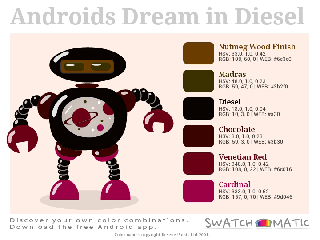Ever wondered why the colours you have chosen don't quite gel together in your interior decoration, the clothes you wear, your work space? Are you wanting to add another layer to your colours but don't know where to start? Do you use mood boards?
So many questions and many more, but the answers are all here, in a portable instant mood board.
You might find the swatchmatic android app, a very useful and easy tool to use. It is a camera that analyses the colours of objects and views it is pointed at, a gentle wobble will bring in a whole new range of colours. To save them, all you do is click the cross in the middle. These colours are translated by their relative ratios to each other and are placed on a cartoon robot so you can see them in combination. Each colour is also listed with its computer index number, and the shade name. These shade names are those of the paint company and are copyrighted.
What is really amazing is that it picks up colours hidden in shadows, and you can increase and decrease the size of the analysing window to influence a wider range of colours. The robot sampled here is my kitchen floor, which is mid brown wooden floor (with many shades of orange, gold and brown). By pointing the SwatchMatic to include some shadow, it has picked up on some lovely rich purples as well.
There are a selection of filters to use which bring even more combinations, including a white. This changes the colour selection to white tones. These filters can be used in combination as well, creating more options.




